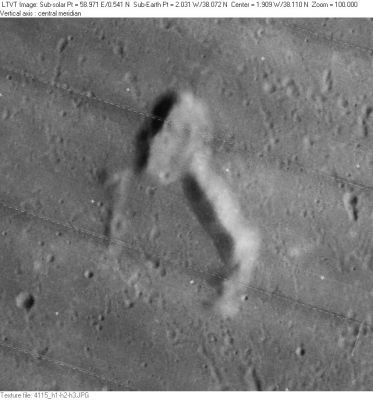Piton Gamma
Contents
Piton Gamma
(discontinued IAU name)
|
Lat: 38.1°N, Long: 1.9°W, Diam: 20 km, Height: 0.6 km, Rükl 12 |
Table of Contents
[#Piton Gamma Piton Gamma]
[#Piton Gamma-Images Images]
[#Piton Gamma-Maps Maps]
[#Piton Gamma-Description Description]
[#Piton Gamma-Additional Information Additional Information]
[#Piton Gamma-Nomenclature Nomenclature]
[#Piton Gamma-Beerenberg on Jan Mayen Beerenberg on Jan Mayen]
[#Piton Gamma-LPOD Articles LPOD Articles]
[#Piton Gamma-Bibliography Bibliography]

LO-IV-115H
Piton Gamma, the "J" shaped hill south-southwest of Mons Piton, and northeast of the Montes Spitzbergen, should be called Jan Mayen because of the similarities on earth. Near the terrestrial Spitzbergen there's also an isle called Jan Mayen. - DannyCaes DannyCaes Aug 4, 2014
Images
LPOD Photo Gallery Lunar Orbiter Images
- Although the name Piton Gamma is not included in the LPI's searchlist of orbital Apollo photographs, it WAS photographed during the mission of Apollo 15!
- Piton Gamma was frequently captured on the metric (mapping) Fairchild camera magazine Revolution 35 (Apollo 15's only north-looking Fairchild magazine).
- In REV 35's frame AS15-M-1542 it (Piton Gamma) is noticeable slightly to the left of the curved horizon's most "vertical" part (very near the central part of the depicted horizon).
- Research orbital Apollo 15 photography: Danny Caes
Maps
(LAC zone 25C1) LAC map Geologic map
Description
Additional Information
- Piton Gamma rises 600m above the mare on its west according to Boint. - fatastronomer fatastronomer
- The shadows in LO-IV-110H and LO-IV-115H suggest that the ridge-like southern extension of Piton Gamma is taller than the thicker segment on the north. The height deduced from these relatively short shadows is about 900-1000 m for the ridge, compared to 600-700 m for the northern headland. This interpretation conflicts with Earth-based photos showing longer shadows, which suggest the southern ridge is lower than the northern headland. Two possible explanations of the anomalous shadow lengths in the Lunar Orbiter views are that their western tips are falling in a depressed trench; or that they are not "complete" shadows, but rather merely darkened areas due to the sunlight streaming over rough terrain at an angle close to the surface slope. Although the shadows appear to grow slightly in the 12 hours between LO-IV-110H and LO-IV-115H, there is no evidence of a trench in Earth-based photos, so the latter explanation seems the most likely.
Nomenclature
- Named after the nearby peak (Mons Piton).
- According to Mary Blagg's Collated List, this feature (catalog #1136) was originally known as Kirch Gamma, however the IAU appears to have re-assigned it to Mons Piton and it was called Piton Gamma in their Named Lunar Formations of 1935. - JimMosher JimMosher
- When the IAU Latinized lunar names in 1961, the correct designation probably became Mons Piton Gamma, although there is no clear documentation about this. - JimMosher JimMosher
- This name was discontinued in 1973, along with nearly all other Greek-lettered designations. - JimMosher JimMosher
- Piton Gamma, the "isle" south-southwest of Mons Piton and north-northeast of Montes Spitzbergen, is unofficially called Jan Mayen by Danny Caes. The terrestrial isle Jan Mayen is also located near the Spitzbergen group. - DannyCaes DannyCaes Feb 22, 2008
Beerenberg on Jan Mayen
- The pronounced northern part of Piton Gamma (or Jan Mayen) could be called Beerenberg (Bear Mountain), which is the stratovolcano on the terrestrial island Jan Mayen. Note: it should be mentioned that it is possible to detect the location of this stratovolcano on Meteosat photography, even when that part of the northern Atlantic ocean is covered by a dense clouddeck! (discovered by D.Caes on wednesday the 7th of October 2015, on that day the location of the stratovolcano Beerenberg was indicated by a white spot "above" the clouddeck). - DannyCaes DannyCaes Oct 7, 2015
LPOD Articles
Bibliography
This page has been edited 1 times. The last modification was made by - tychocrater tychocrater on Jun 13, 2009 3:24 pm - afx4